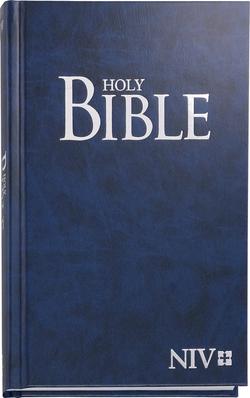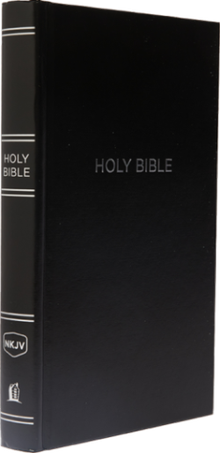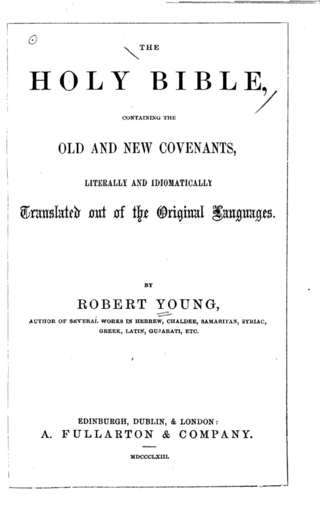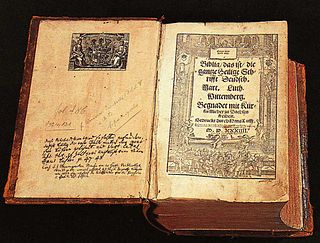
The New International Version (NIV) is a translation of the Bible into contemporary English. Published by Biblica, the complete NIV was released in 1978 with a minor revision in 1984 and a major revision in 2011. The NIV relies on recently-published critical editions of the original Hebrew, Aramaic, and Greek texts.

The Masoretic Text is the authoritative Hebrew and Aramaic text of the 24 books of the Hebrew Bible (Tanakh) in Rabbinic Judaism. The Masoretic Text defines the Jewish canon and its precise letter-text, with its vocalization and accentuation known as the mas'sora. Referring to the Masoretic Text, masorah specifically means the diacritic markings of the text of the Jewish scriptures and the concise marginal notes in manuscripts of the Tanakh which note textual details, usually about the precise spelling of words. It was primarily copied, edited, and distributed by a group of Jews known as the Masoretes between the 7th and 10th centuries of the Common Era (CE). The oldest known complete copy, the Leningrad Codex, dates from the early 11th century CE.

The New World Translation of the Holy Scriptures is a translation of the Bible published by the Watch Tower Bible and Tract Society; it is used and distributed by Jehovah's Witnesses. The New Testament portion was released first, in 1950, as The New World Translation of the Christian Greek Scriptures, with the complete New World Translation of the Bible released in 1961.

The New Living Translation (NLT) is a translation of the Bible in contemporary English. Published in 1996 by Tyndale House Foundation, the NLT was created "by 90 leading Bible scholars." The NLT relies on recently published critical editions of the original Hebrew, Aramaic, and Greek texts.

The English Standard Version (ESV) is a translation of the Bible in contemporary English. Published in 2001 by Crossway, the ESV was "created by a team of more than 100 leading evangelical scholars and pastors." The ESV relies on recently published critical editions of the original Hebrew, Aramaic, and Greek texts.

The New King James Version (NKJV) is a translation of the Bible in contemporary English. Published by Thomas Nelson, the complete NKJV was released in 1982. With regard to its textual basis, the NKJV relies on a modern critical edition for the Old Testament, while opting to use the Textus Receptus for the New Testament.

Modern English Bible translations consists of English Bible translations developed and published throughout the late modern period to the present.

The Recovery Version is a modern English translation of the Bible from the original languages, published by Living Stream Ministry, ministry of Witness Lee and Watchman Nee. It is the commonly used translation of Local Churches (affiliation).

Young's Literal Translation (YLT) is a translation of the Bible into English, published in 1862. The translation was made by Robert Young, compiler of Young's Analytical Concordance to the Bible and Concise Critical Comments on the New Testament. Young used the Textus Receptus (TR) and the Masoretic Text (MT) as the basis for his translation. He wrote in the preface to the first edition, "It has been no part of the Translator's plan to attempt to form a New Hebrew or Greek Text—he has therefore somewhat rigidly adhered to the received ones." Young produced a "Revised Version" of his translation in 1887, but he stuck with the Received Text. He wrote in the preface to the Revised Edition, "The Greek Text followed is that generally recognized as the 'Received Text,' not because it is thought perfect, but because the department of Translation is quite distinct from that of textual criticism, and few are qualified for both. If the original text be altered by a translator, the reader is left in uncertainty whether the translation given is to be considered as that of the old or of the new reading." A new Revised Edition was released ten years after Robert Young's death on October 14, 1888. The 1898 version was based on the TR, easily confirmed by the word "bathe" in Revelation 1:5 and the word "again" in Revelation 20:5. The "Publishers' Note to the Third Edition" explains, "The work has been subjected to a fresh revision, making no alteration on the principles on which the Translation proceeds, but endeavouring to make it as nearly perfect in point of accuracy on its present lines as possible." A major revision of Young's Literal Translation in contemporary English, called the Literal Standard Version, was released in 2020.

The Biblia Hebraica Stuttgartensia, abbreviated as BHS or rarely BH4, is an edition of the Masoretic Text of the Hebrew Bible as preserved in the Leningrad Codex, and supplemented by masoretic and text-critical notes. It is the fourth edition in the Biblia Hebraica series started by Rudolf Kittel and is published by the Deutsche Bibelgesellschaft (German Bible Society) in Stuttgart.
Several Spanish translations of the Bible have been made since approximately 700 years ago.
The Lockman Foundation is a nonprofit, interdenominational Christian ministry dedicated to the translation, publication, and distribution of Bibles and other biblical resources in English and other languages. The foundation's core products are the New American Standard Bible and the Amplified Bible, both evolving from the 1901 American Standard Version. By 2009, the foundation had distributed about 25 million Bibles.
Olive Tree Bible Software creates Biblical software and mobile apps, and is an electronic publisher of Bible versions, study tools, Bible study tools, and Christian eBooks for mobile, tablet, and desktop devices. The firm is headquartered in Spokane, Washington and is a member of the Evangelical Christian Publishers Association (ECPA). Olive Tree currently supports Android, iPad, iPhone, Macintosh, Windows, and personal computer devices.
The Holy Bible: Easy-to-Read Version (ERV) is an English translation of the Bible compiled by the World Bible Translation Center. It was originally published as the English Version for the Deaf (EVD) by BakerBooks.
The Common English Bible (CEB) is an English translation of the Bible whose language is intended to be at a comfortable reading level for the majority of English readers. The translation, sponsored by an alliance of American mainline Protestant denomination publishers, was begun in late 2008 and was finished in 2011. It uses gender-inclusive language and some editions sold include the books of the Apocrypha which are used by the Catholic Church, Orthodox Church, and in some Anglican congregations.

A Protestant Bible is a Christian Bible whose translation or revision was produced by Protestant Christians. Typically translated into a vernacular language, such Bibles comprise 39 books of the Old Testament and 27 books of the New Testament, for a total of 66 books. Some Protestants use Bibles which also include 14 additional books in a section known as the Apocrypha bringing the total to 80 books. This is in contrast with the 73 books of the Catholic Bible, which includes seven deuterocanonical books as a part of the Old Testament. The division between protocanonical and deuterocanonical books is not accepted by all Protestants who simply view books as being canonical or not and therefore classify books found in the Deuterocanon, along with other books, as part of the Apocrypha. Sometimes the term "Protestant Bible" is simply used as a shorthand for a bible which contains only the 66 books of the Old and New Testaments.
George Vernon Blankenbaker is an American Old Testament theologian and one of only three scholars who worked on both the original 1971 translation of the New American Standard Bible as well as the 1995 update. He is the author of The Language of Hosea 1-3. During his career, he served as vice-president and academic dean of Westmont College, where he currently serves as dean emeritus.
The Literal English Version of Scripture (LEV) is a translation of the Bible based on the World English Bible. Formerly known as the "Shem Qadosh Version", the title was officially changed in November 2016. It is considered a Sacred Name Bible rendering the name of God using the Hebrew characters יהוה, and that of Jesus in Hebrew as ישוע. It was created by a team of volunteers across the United States with additional proofing and editing assistance by individuals in Poland and Taiwan. Footnotes and appendices were written by the General Editor, J. A. Brown.

The Christian Standard Bible (CSB) is a translation of the Bible in contemporary English. Published by Holman Bible Publishers in 2017 as the successor to the Holman Christian Standard Bible (HCSB), the CSB "incorporates advances in biblical scholarship and input from Bible scholars, pastors, and readers to sharpen both accuracy and readability." The CSB relies on recently published critical editions of the original Hebrew, Aramaic, and Greek texts.
The Legacy Standard Bible (LSB) is an English translation of the Bible that was released in 2021. It is an update to the New American Standard Bible Updated Edition, with permission from the Lockman Foundation, as an alternative to the 2020 Revision of the NASB. The LSB was produced and edited by a team of faculty from The Master's Seminary and is published by Three Sixteen Publishing, Inc., in partnership with the Lockman Foundation and with funding from the John MacArthur Charitable Trust.












